
Carmilla is an 1872 Gothic novella by Irish author Sheridan Le Fanu and one of the early works of vampire fiction, predating Bram Stoker's Dracula (1897) by 25 years. First published as a serial in The Dark Blue (1871–72), the story is narrated by a young woman preyed upon by a female vampire named Carmilla. The lead character is the original prototypical example of the lesbian vampire, expressing romantic desires toward the protagonist. The story is often anthologised, and has been adapted many times in films, movies, games, television and other media.
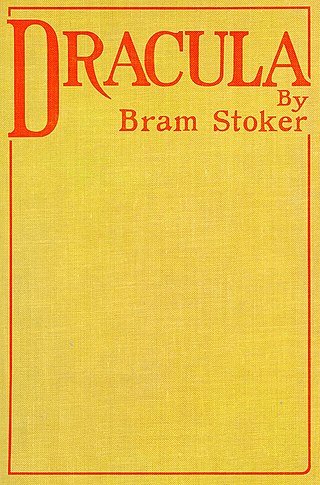
Dracula is a 1897 Gothic horror novel by Irish author Bram Stoker. An epistolary novel and a classic of English literature, the narrative is related through letters, diary entries, and newspaper articles. It has no single protagonist and opens with solicitor Jonathan Harker taking a business trip to stay at the castle of a Transylvanian nobleman, Count Dracula. Harker escapes the castle after discovering that Dracula is a vampire, and the Count moves to England and plagues the seaside town of Whitby. A small group, led by Abraham Van Helsing, investigate and hunt the vampire.

Gothic fiction, sometimes called Gothic horror, is a loose literary aesthetic of fear and haunting. The name refers to Gothic architecture of the European Middle Ages, which was characteristic of the settings of early Gothic novels.
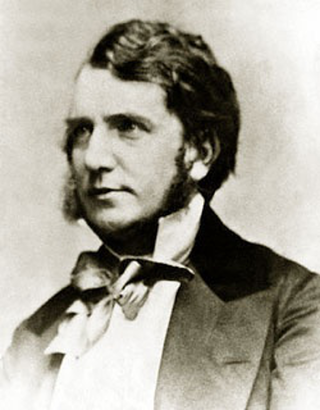
Joseph Thomas Sheridan Le Fanu was an Irish writer of Gothic tales, mystery novels, and horror fiction. He was a leading ghost story writer of his time, central to the development of the genre in the Victorian era. M. R. James described Le Fanu as "absolutely in the first rank as a writer of ghost stories". Three of his best-known works are the locked-room mystery Uncle Silas, the vampire novella Carmilla, and the historical novel The House by the Churchyard.

Vampire literature covers the spectrum of literary work concerned principally with the subject of vampires. The literary vampire first appeared in 18th-century poetry, before becoming one of the stock figures of gothic fiction with the publication of Polidori's The Vampyre (1819), inspired by a story told to him by Lord Byron. Later influential works include the penny dreadful Varney the Vampire (1847); Sheridan Le Fanu's tale of a lesbian vampire, Carmilla (1872), and the most well known: Bram Stoker's Dracula (1897). Some authors created a more "sympathetic vampire", with Varney being the first, and more recent examples such as Moto Hagio's series The Poe Clan (1972–1976) and Anne Rice's novel Interview with the Vampire (1976) proving influential.
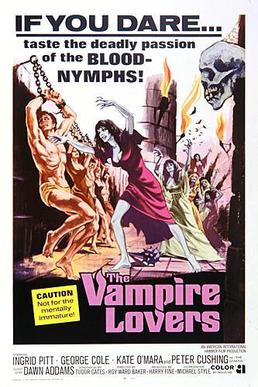
The Vampire Lovers is a 1970 British Gothic horror film directed by Roy Ward Baker and starring Ingrid Pitt, Peter Cushing, George Cole, Kate O'Mara, Madeline Smith, Dawn Addams, Douglas Wilmer and Jon Finch. It was produced by Hammer Film Productions. It is based on the 1872 Sheridan Le Fanu novella Carmilla and is the first film in the Karnstein Trilogy, the other two films being Lust for a Vampire (1971) and Twins of Evil (1971). The three films were somewhat daring for the time in explicitly depicting lesbian themes.

Christabel is a long narrative ballad by Samuel Taylor Coleridge, in two parts. The first part was reputedly written in 1797, and the second in 1800. Coleridge planned three additional parts, but these were never completed. Coleridge prepared for the first two parts to be published in the 1800 edition of Lyrical Ballads, his collection of poems with William Wordsworth, but left it out on Wordsworth's advice. The exclusion of the poem, coupled with his inability to finish it, left Coleridge in doubt about his poetical power. It was published in a pamphlet in 1816, alongside Kubla Khan and The Pains of Sleep.

Lesbian vampirism is a trope in early gothic horror and 20th century exploitation film. The archetype of a lesbian vampire used the fantasy genre to circumvent the heavy censorship of lesbian characters in the realm of social realism.
The Karnstein Trilogy is a series of vampire films produced by Hammer Films. They were notable at the time for their daring lesbian storylines. All three films were scripted by Tudor Gates. All three feature vampires of the noble Karnstein family, and their seat Castle Karnstein near the town of Karnstein in Styria, Austria.

LGBTQ themes in horror fiction refers to sexuality in horror fiction that can often focus on LGBTQ+ characters and themes within various forms of media. It may deal with characters who are coded as or who are openly LGBTQ+, or it may deal with themes or plots that are specific to gender and sexual minorities.

Lust for a Vampire, also known as Love for a Vampire or To Love a Vampire, is a 1971 British Hammer Horror film directed by Jimmy Sangster, starring Ralph Bates, Barbara Jefford, Suzanna Leigh, Michael Johnson, and Yutte Stensgaard. It was given an R rating in the United States for some violence, gore, strong adult content and nudity. It is the second film in the Karnstein Trilogy, loosely based on the 1872 Sheridan Le Fanu novella Carmilla. It was preceded by The Vampire Lovers (1970) and followed by Twins of Evil (1971). The three films do not form a chronological development, but use the Karnstein family as the source of the vampiric threat and were somewhat daring for the time in explicitly depicting lesbian themes.
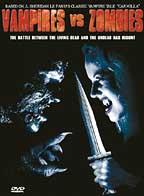
Vampires vs. Zombies is a 2004 American independent horror film loosely based upon J. Sheridan Le Fanu's classic 1872 novel Carmilla. Unlike Le Fanu's story, however, most of the action in the film takes place inside a car. The title and cover artwork were obviously inspired by the then-current horror film Freddy vs. Jason, but the movie itself bears less resemblance to this counterpart compared to other, more blatant Asylum mockbusters. The movie was originally titled Vampires vs. Zombies, but it has since then been changed to Carmilla, the Lesbian Vampire. Vince D'Amato is the director and screenwriter of this film.
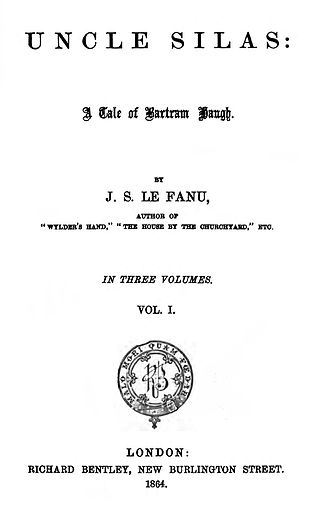
Uncle Silas, subtitled "A Tale of Bartram Haugh", is an 1864 Victorian Gothic mystery-thriller novel by the Irish writer J. Sheridan Le Fanu. Despite Le Fanu resisting its classification as such, the novel has also been hailed as a work of sensation fiction by contemporary reviewers and modern critics alike. It is an early example of the locked-room mystery subgenre, rather than a novel of the supernatural, but does show a strong interest in the occult and in the ideas of Emanuel Swedenborg, a Swedish scientist, philosopher and Christian mystic.

In a Glass Darkly is a collection of five stories by Sheridan Le Fanu, first published in 1872, the year before his death. The second and third stories are revised versions of previously published stories. The first three stories are short stories, and the fourth and fifth are long enough to be called novellas.

Carmilla is a Canadian single-frame web series co-created by Jordan Hall, Steph Ouaknine, and Jay Bennett. The series stars Elise Bauman and Natasha Negovanlis, and is loosely based on the novella of the same name by Sheridan Le Fanu. The series premiered on the Vervegirl YouTube channel on August 19, 2014. U by Kotex is the executive producer of the web series. The series takes place at the fictional Silas University in Styria, Austria, and is told through vlogs recorded by Laura, a first-year student. When Laura begins investigating the disappearance of her roommate, she is assigned a new roommate named Carmilla.

The Unwanted is a 2014 American thriller film written and directed by Bret Wood. It is based on the novel Carmilla by Sheridan Le Fanu but was transposed from a Gothic tale set in Austria to a Southern Gothic setting. It stars Christen Orr in the title role, a woman who comes to a small town in the Southern US to investigate the mother she never knew. Along the way, she meets Laura and her father Troy, locals who may know something about her mother. It premiered at the Atlanta Film Festival on March 31, 2014, and Kino International released it on DVD on July 14, 2015.
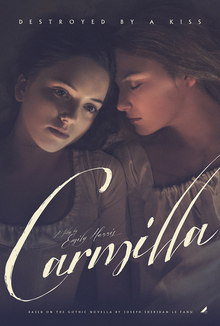
Carmilla is a 2019 British romantic vampire horror film written and directed by Emily Harris in her feature directorial debut. Based on the 1871 novella of the same name by Sheridan Le Fanu, it stars Jessica Raine, Hannah Rae, Devrim Lingnau, Tobias Menzies, and Greg Wise. The film follows a lonely woman preyed upon by the titular vampire.

The Carmilla Movie is a 2017 Canadian comedy horror film directed by Spencer Maybee, based on the web series of the same name (2014–2016). Both the film and the web series were adapted from the 1872 gothic novella Carmilla by Joseph Sheridan Le Fanu. The film received a limited release in Canada on October 26, 2017.

The Blood of the Vampire is a Gothic novel by Florence Marryat, published in 1897. The protagonist, Harriet Brandt, is a mixed-race psychic vampire who kills unintentionally. The novel follows Harriet after she leaves a Jamaican convent for Europe, and her ill-fated attempts to integrate with Victorian society.
Irish Gothic literature developed in the eighteenth and nineteenth centuries. Most of the writers were Anglo-Irish. The period from 1691 to 1800 was marked by the dominance of the Protestant Ascendancy, Anglo-Irish families of the Church of Ireland who controlled most of the land. The Irish Parliament, which was almost exclusively Protestant in composition, passed the Penal Laws, effectively disenfranchising the Catholic majority both politically and economically. This began to change with the Acts of Union 1800 and the concomitant abolition of the Irish Parliament. Following a vigorous campaign led by Irish lawyer Daniel O'Connell, Westminster passed the Roman Catholic Relief Act 1829 removing most of the disabilities imposed upon Catholics.















